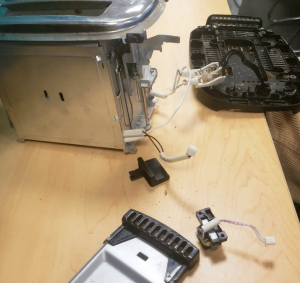In 2024, we hosted two two-week workshops. One was for ~50 students in grades 5-7, and the other for ~50 students in grades 6-8. We collected survey data before and after each workshop which we plan to analyze and use to inform future research and workshops, but here is a quick reflection and some pictures of the event.
A brief reflection on the workshop:
Through these workshops we hoped to teach three main things. Firstly, we wanted for students to develop some technical understanding – enough to be able to continue to take apart electronics themselves, use basic tools and reason about simple circuits. Secondly we wanted to have students start thinking about the impact of electronics and computers on the environment, and to better understand the relationship between engineering/design, consumer decisions, and environmental impacts. Lastly, we wanted to get students interested in electrical and computer engineering, and to encourage them to reconsider how they use and understand their electronics – to start thinking ‘how does this work?’ when it comes to the devices they use everyday, and then ‘what does this mean for the environment?’, and then ‘how can I make a difference here’.
In both workshops, throughout the three hour sessions the students disassembled and examined basic household electronics in groups of five. Approximately fifteen minute chunks of activity with the circuits (disassembling the circuit, measuring electrical properties, drawing circuit diagrams) was interspersed with brief periods of lecturing. We also incorporated large group discussion and activities in these lectures. This largely went well. I think it was pretty clear throughout the session that most students were very engaged and seemed to be having a great time. We only briefly evaluated learning outcomes, by asking students at the end of the session what they had learned, but I was happy that they came up with many different answers that covered most of the learning objectives that I had in mind: “I learned what e-waste was”, “I learned how to use a multimeter”, “I learned about different circuit components”, “I learned how to take something apart”. In the class discussions, I was really happy to see that some of the graphics and discussion prompts that I had made were effective in starting some interesting discussion around sustainability!
There were some parts of the lesson that didn’t work so well. By the end of the three hours, some of the younger students had gotten pretty excited with all the hands-on work and had trouble settling down into quiet discussion. The last part of my lesson I think was a little complex for the younger group, especially once they were a little restless and excited. When asked about what they had learned, some of the class was also pretty focused on the physical fun activities, and didn’t seem to be linking them to the higher level topics. I wonder if this link – between the most abstract topics (right to repair, planned obsolescence, and sustainable design), and the in class activities seemed a little tenuous and could have been better emphasized.
Pictures from the workshop



Examples of Circuit Diagrams





